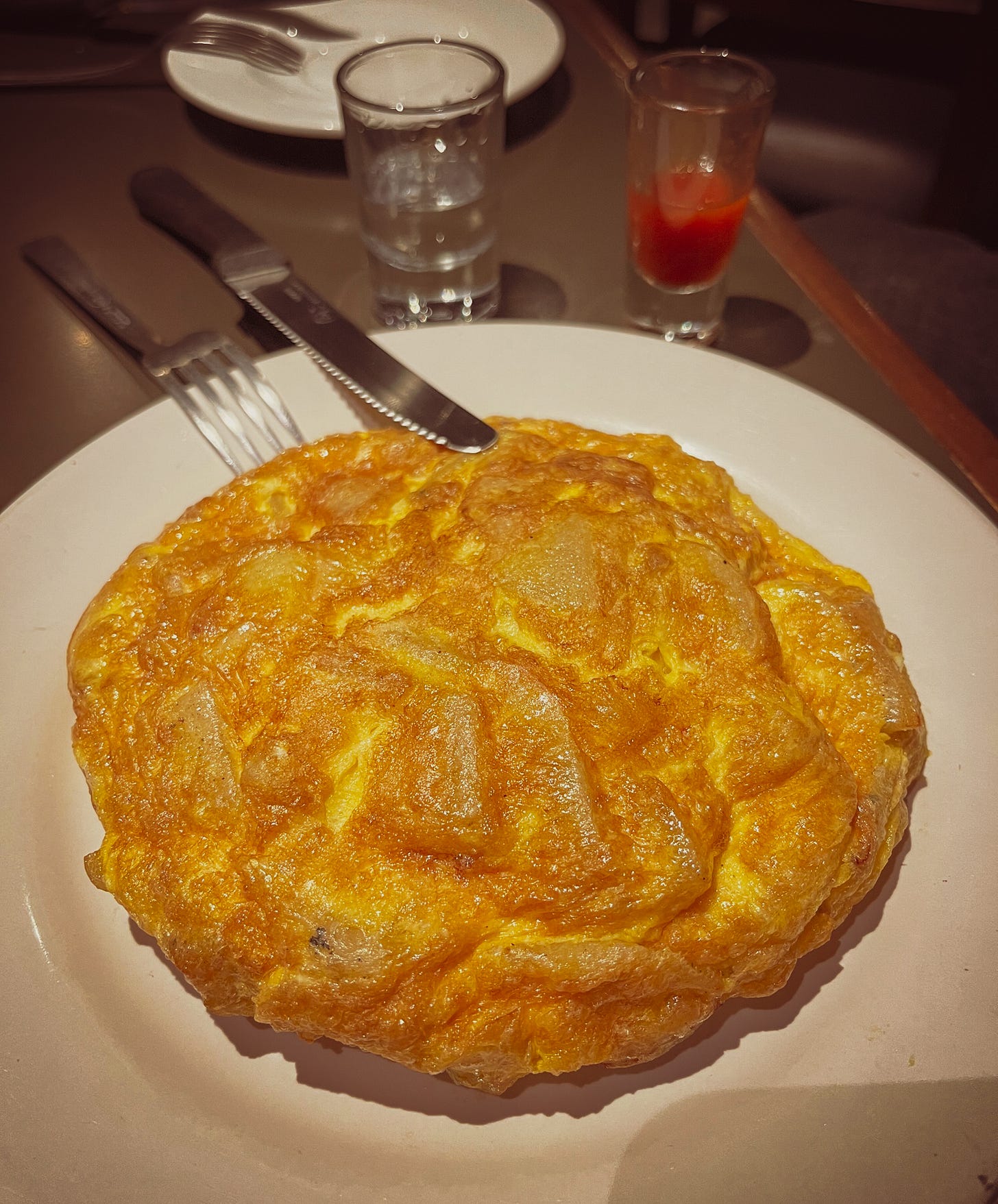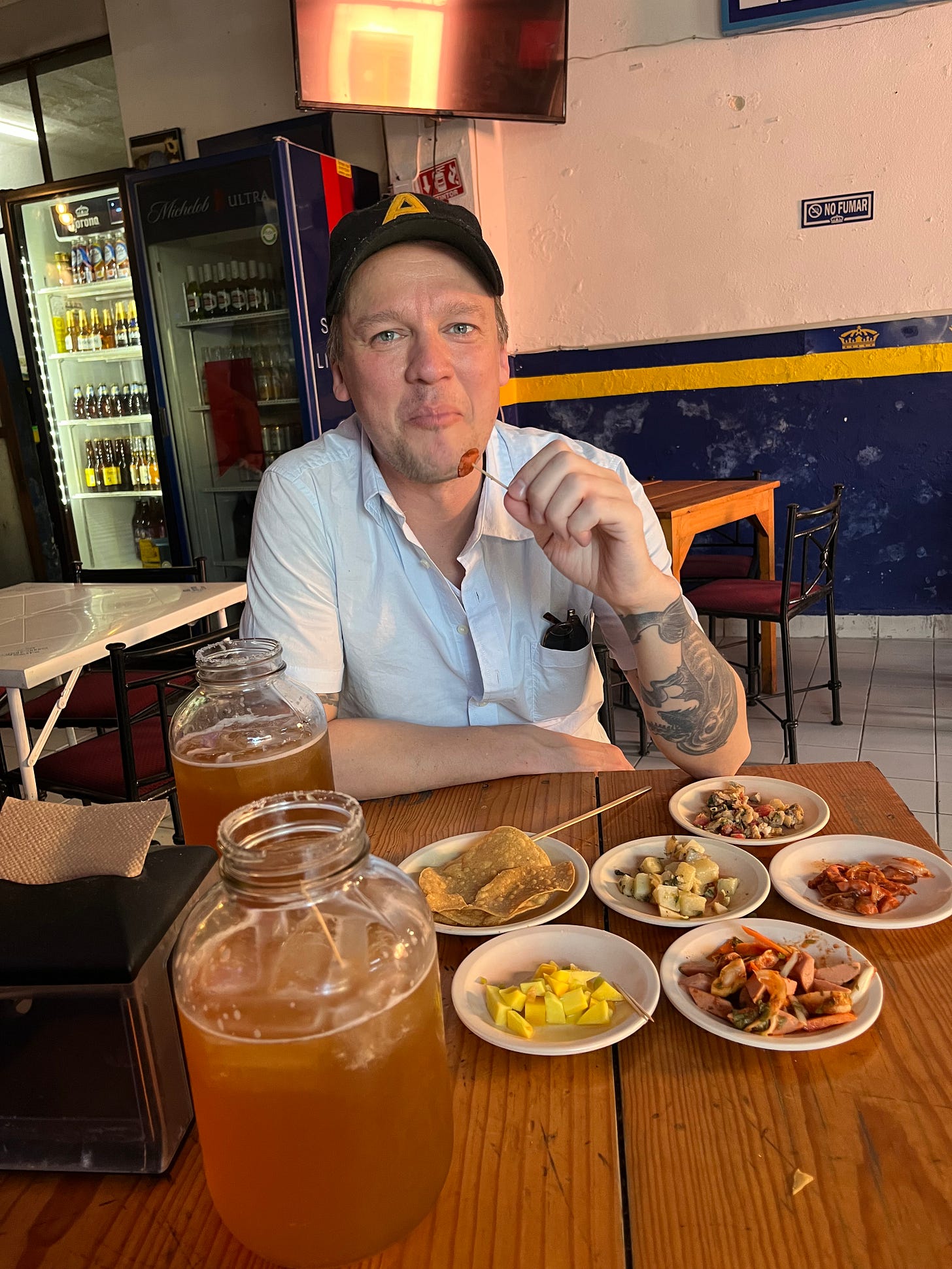On the Cantina Trail
A behind-the-swinging doors look at Mexico's storied drinking dens, from Mexico City to Mérida
Set foot in any major city or rural outpost throughout Mexico and you are bound to happen across a neighborhood watering hole known as a cantina. Originating in the mid-1800s as men-only establishments where patrons gathered to drink, chat and play cards or dominoes, cantinas reached the apex of popularity in the 1940s and 1950s. Though they now admit women and children and the air of machismo is less stifling than it once was, today’s cantinas are a throwback to an earlier era. The best of them retain their period decor, offer free botanas (snacks) and feature roving musicians. Stepping into one of these storied drinking dens is like taking a step back in time.
Our first introduction to the cantina was at Mexico City’s El Centenario. Located in the posh Condesa neighborhood, it exists in dramatic contrast to the chic bars and European-style bistros that surround it, proudly announcing its incongruity on its awning—“desde 1948” (in continuous operation since 1948).
Waiters in formal uniforms beckon you into a room clad with decorative tiles where a bull’s head and bullfighting posters nod to the nominally Spanish origins of Mexico’s cantina culture. The a la carte menu also features Spanish classics such as tortilla española, the traditional potato, egg and onion omelet, which we often ordered alongside a popular Mexican dish—flautas de pollo (fried tortillas filled with shredded chicken dressed in queso fresco, crema and shredded lettuce).
On a typical Friday night, the crowd at El Centenario ranges from groups of co-workers unwinding after a long week to the four regulars who always take their place at the bar, graying gents in Killing Joke rock band t-shirts and denim playing Dio and Dire Straits on the streaming music platform.
Regardless of their backstory, everyone is drinking beer, beer cocktails, tequila or mezcal. At El Centenario agave-based spirits are served with the traditional Mexico City accompaniment of sangrita (a heady mix of orange juice, tomato juice and fresh lime, along with chile and Worcestershire sauce). The etiquette is to sip some of the liquor and alternate with sips of the sangrita, whose flavors are meant to complement the flavors of the spirit. Of course, in cantinas things can tend to get out of hand, and on more than one occasion we witnessed Chilangos (as residents of Mexico City are known), downing their tequila and mezcal in one gulp.
In addition to the boisterous energy created by the Friday night revelers, there are strolling Norteño musicians, Mariachis, and a lone guitarist who entertain the crowd throughout the evening along with vendors selling anything from cigarettes to spiced nuts to fresh cheese.
Coming from Chicago, a city where the corner bar reigns supreme, this was a place with true personality that felt familiar (a no-frills appearance and boisterous atmosphere) and yet entirely of its place (live Mariachi music standing in for the dive-bar jukebox). We developed a fondness for El Centenario that we have been eager to locate ever since we left Mexico City at the end of March 2022.
–
We came to Mérida one year later, in March 2023, with the knowledge that the capital of Yucatán State boasts one of the strongest cantina cultures in all of Mexico. The assignment: find the platonic ideal of our favorite Mexico City cantina in seven days’ time.
Mérida’s cantinas are known as “centros botaneros” because the botanas, small plates of salty, often spicy snacks, are arguably as central to the experience as the drinks themselves. The city claims somewhere between 100 and 150 cantinas, many of which are more than one hundred years old, although it does appear that a vast number have closed within the past decade, owing largely to changing tastes and rapidly accelerated by the pandemic.
Almost all keep the hours of noon to 10pm and unlike in Mexico City, the drink of choice in these regional saloons is beer—tequila and mezcal are much less popular in this part of the country because they are deemed “Mexican” as opposed to Yucatecan (the people of Mérida are fiercely proud of their regional heritage) and because the hot, humid weather demands the consumption of a cold beverage rather than a room temperature liquor.
It is not uncommon to see groups of women at Mérida’s canteens, whereas in more conservative parts of Mexico cantinas remain the purview of male-only clientele. The custom of women and men commingling in cantinas emerged in Mérida in the middle of the twentieth century, thanks in large part to a popular radio program, La Hora Cristal (The Crystal Hour), as David Sterling explains in his outstanding tome Yucatán: Recipes from a Culinary Expedition.
The show featured popular music by request and aired from noon to 2pm, and men and women would leave work or home to gather at cantinas with friends and family to enjoy the program together over a beer and a snack. Even though the radio program is no longer broadcast, today many people still uphold the tradition of the hora cristal during their lunch break before heading back to work or going home for a siesta.
Our first night in Mérida we stopped by El Gallito, a celebrated cantina familiar (family cantina) housed in a colonial-style building painted white and trimmed with decorative blue tiles. The namesake rooster presides over the entrance, which by law, is adorned with swinging saloon doors to protect innocent passersby from exposure to what happens inside.
When we entered around 7pm on a weeknight, the crowd at the cantina was quite tame—several regulars were nursing drinks and chatting at the bar lined with ceramic roosters, glancing periodically at the soccer game on TV. These locals (known as parroquianos, or parishioners, in Yucatecan parlance) are so essential to the fabric of El Gallito that there is a row of glasses behind the bar with the name of the patron etched into the glass and also identified in blue marker on the wood ledge below.
We were immediately smitten with the bar’s unassuming nature—the bright, fluorescent lighting bouncing off of institutional floor tiles—and the affable staff. It was surprising to learn that like many of Mérida’s cantinas, El Gallito isn’t owned by an individual proprietor but instead by the Modelo Group, the powerhouse maker and distributor of beer brands Corona, Pacifico, Victoria, etc. Whereas America’s brand-owned bars are bland, antiseptic environments where no local would ever be caught dead, Mérida’s classic cantinas—charming interiors packed with local devotees—track with the best of America’s dive bars.
The waiter invited us to take a seat at one of the tables in the front room, where one other couple was seated, and in my not-so-polished Spanish I ordered dos cheladas—what I have come to understand to be a preparation of fresh squeezed lime juice in the bottom of a beer mug lined with a rim of salt—con dos Victorias, our beer of choice. (The chelada is not to be confused with the more well-known michelada, wherein the lime juice is mixed with Worcestershire sauce and some form of chile and poured into a mug lined with tajín, chamoy or some other spicy/tangy seasoning). The mug for the chelada is brought to the table, already filled with lime juice and rimmed with salt, along with the bottle of beer, and the server typically pours in as much beer as the mug can accommodate. You are then left to continue pouring the beer, which mixes with the tart lime and creates one of the most refreshing drinks on earth.
However, when our server came back to the table, he presented two mugs rimmed with salt, no lime juice or liquid of any kind in the bottom of the mug.
I figured I had misspoken, or that chelada was a Mexico City term, but he took one look at the mugs, shook his head, and immediately turned around to chastise the bartender for forgetting to add the lime juice. He promptly returned with our lime juice-filled mugs, added a portion of our beer, and left us to enjoy that first refreshing quench.
After we settled in he asked if we wanted botanas to accompany our drinks, and of course we did. He returned with four, bread and butter-size plastic plates of botanas along with a basket of totopos. These fried tortilla chips were rather limp, owing to the excessive humidity of Mérida’s climate, but it was no matter because the two spreadable dips before us were worth suffering the mediocre conveyance.
Neither looked visually appealing—one was a smear of grayish-black beans, crusting over in the corners. The other resembled something scooped off of the sidewalk, a ruddy glop of olive green with red flecks the consistency of chunky hummus. However, after just one bite we realized this was anything but run-of-the mill bar food.
The beans were mashed by hand and mixed with diced onion that had been sauteed to the point of near-melting. The star of the show was that earthy dip, a harmonious amalgamation of ground, toasted pepitas, chiles, onions, raw tomato and cilantro. It wasn’t much to look at, but it made our taste buds dance. I already knew what I was eating, sikil pak (in Mayan sikil = squash seed, palak = tomato), but when the server came back to check on us, I asked him what this dish was because I wanted to hear him pronounce it for us. “See-keel-pack,” the k’s punctuating the stagnant heat and humidity like a knife piercing a balloon.
In addition to these humble purees, we were served sliced hot dog coins in a tomato sauce—they may have been called salchicha, but let’s be honest, they were your classic canned hot dogs—and some limp spaghetti. As someone who has lived in Italy, and worked in the cooking school at Eataly (the Italian food superstore) where I regularly preached the gospel of serving al dente pasta, I had no business enjoying this overcooked, room temperature spaghetti drowning in a cheese-laden “Alfredo” sauce, but I must admit it was quite delicious.
El Gallito proved a great introduction to the local cantina scene; we were eager to see what else Mérida had in store.
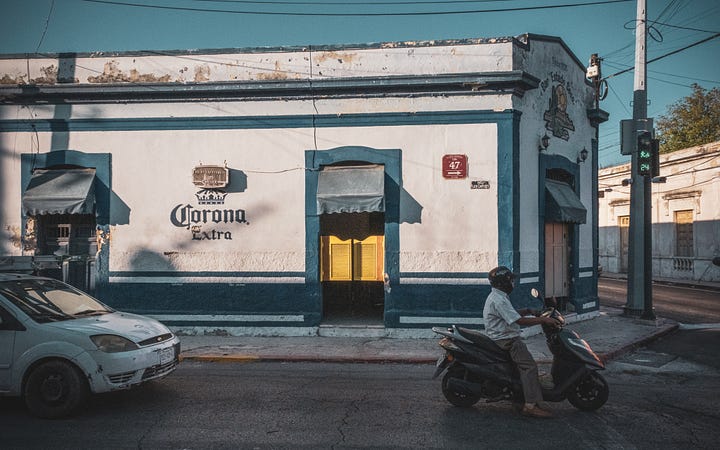

We continued our search the next afternoon at El Estado Seco, a bar located prominently on a corner in the historic centro. The exterior was crumbling in parts, its white paint grayed over by the exhaust fumes from passing motorbikes. The interior possessed a similar atmosphere to that of El Gallito—those same tables and industrial floor tiles, a neon cactus haphazardly placed on the bar. There was only one other table occupied by a man and woman; the bored waitstaff scrolled on their phones and played Banda songs on the TVs.
I had read that the house drink was something called “lince” in the chelada/michelada category. When I ordered two, for myself and my companion, the bartender looked puzzled. When he ambled over from the bar with two giant pickle jars, one under each arm, I instantly understood why. These were the most massive cheladas I had ever seen, each filled with two liters’ worth of beer.
Luckily, we received an ample assortment of tasty botanas to wash down our drinks. Sikil p’aak made its second appearance, with much more heat than El Gallito’s version. We polished it off immediately. There were diced potatoes roasted in butter, fragrant with Mexican oregano, as well as stewed chicharron, a tender version of the more commonly crispy pork rind, mixed with sauteed vegetables. The canned cocktail weenie was also on offer here, this time in a much more appealing preparation of escabeche, that wonderfully spicy pickled mix of carrots, onions and herbs. The palate cleanser was a plate of sliced mango, soaked in fresh lime juice and punctuated by slivers of habanero peppers, though we worked diligently to avoid those bright orange bits when stabbing the mango with our toothpicks. The combined heat of the food and the lack of air conditioning to be found meant that we sweated profusely for the duration of our visit.
On our way back home we decided to try one more cantina in our quest to find the Mérida equivalent of our beloved Mexico City watering hole. Earlier in the day we had passed La Campana Grande, marked by a big, golden bell painted on the wall above the doorway. As we approached the entrance, we could hear the roar of the crowd inside and figured we had finally found our place.
I pushed open those characteristic swinging doors and then slid open a set of glass doors imprinted with beer bottles to be greeted by several women dressed in black lingerie wearing bunny ears. As I was trying to get my bearings, one of the women extended her hands and said “adelante,” which means “come on in.” And so we did.
Once we sat down it became resoundingly clear that I was the only woman not wearing bunny attire. In fact, I was the only “non-working” woman in the joint. We had accidentally happened into an escort bar.
The clientele consisted of men in their 50s and up, some chatting with their buddies over buckets of beer, some on their own, but all with their eyes focused on the scantily-clad women donning bunny ears and cottontails. As Mérida-based writer Stewart Mandy explains, these women are colloquially referred to as bellas edecanes (“beautiful hostesses”) and they will gladly sit at your table and entertain you for the cost of a ficha (a higher-priced drink).
This scene recalled the earliest iteration of the cantina, the rough-around-the-edges version where men came to escape the confines of domestic life. With testosterone coursing through the air and not a single botana to be found, we quickly moved on.
After a lot of laughter and a day off from the cantina trail, we decided to make one final attempt at locating a place that approximated El Centenario. We ended up at El Porvenir; its vibrant magenta walls and turquoise saloon doors caught our eye while biking past earlier in the day. As we neared the entrance we could once again hear the roaring crowd inside, our recent experience at La Campana Grande still ringing (pun unfortunately intended) in our ears. We took a deep breath as we pushed in the doors.
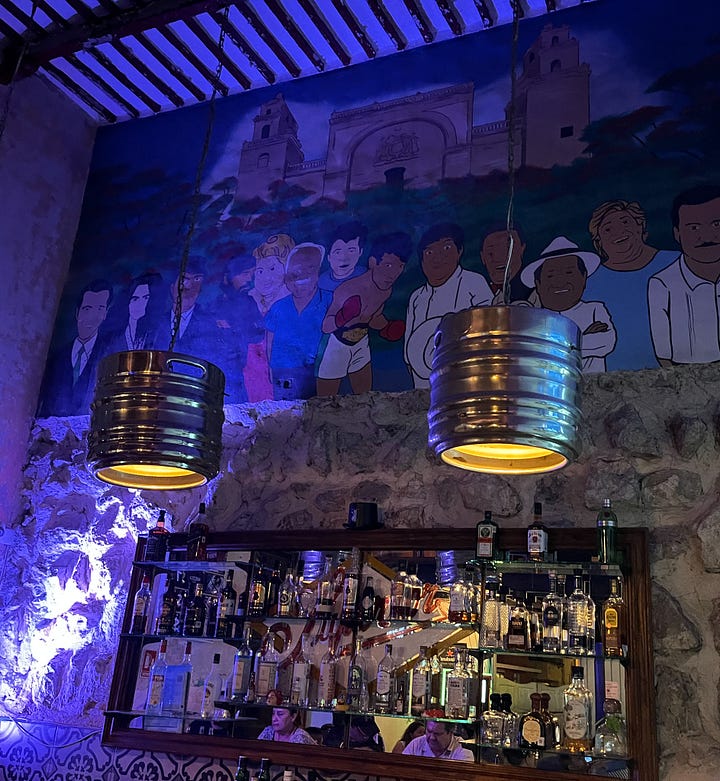
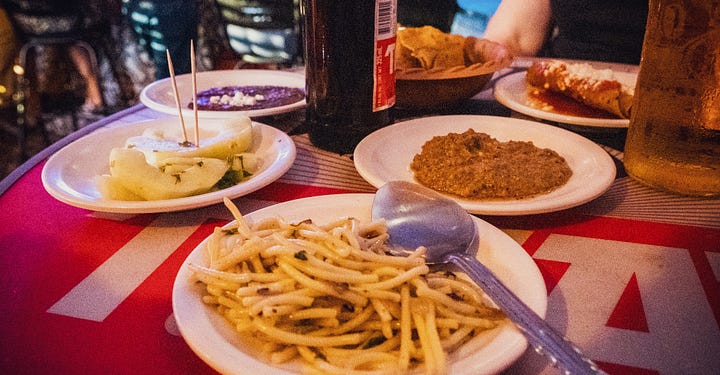
A quick look around the room confirmed that we had found our place. There were groups of women catching up over beers and botanas, a table of men and women still dressed in their civil service uniforms and a lively crowd assembled at the bar.
Taking a seat at the last remaining table in the main room on the first floor, we delighted in the colorful mural behind the bar and the beer kegs-cum-light fixtures that emitted a soft, glowing light. Four enormous fans above our heads did little to temper the hot, humid air inside the packed cantina.
We asked for Victorias, not recognizing the Tecate-branded table tops that indicated that this cantina was owned by the competing Cuauhtémoc Moctezuma (producers of Sol, Superior, Tecate Light, Indio, etc.). We ordered beers (straight beers this time; we didn’t want to mis-order a beer cocktail) and the botanas followed.
These were the spiciest and saltiest, but also the most flavorful assortment we had tried so far. I went right in for the codzitos, deep fried, tightly-rolled tortillas doused in a bright red tomato sauce and generously sprinkled with crumbled queso cotija. Crispy and delicious. The sikil pak had a silkier texture than the previous two versions and was more visually appealing. And we were treated to another version of spaghetti. This time around the mound of pasta was not only room temperature and limpid, but adding insult to injury, it was served with a spoon! Once again, I found myself delighting in this version simply slicked in olive oil and flavored with chopped herbs. The spiciest and yet most refreshing item was a plate with sliced cucumbers doused in lime juice and cilantro. The food was so spicy and the air was so stifling that before we knew it we had each ordered four beers.
The ambience at El Porvenir was pitch-perfect—regulars controlling the jukebox (with music ranging from 90s R&B to recent Banda classics), groups of friends and couples laughing and dancing at the bar. And surprisingly, we found this lively atmosphere on a Monday evening. I was so emboldened by the convivial vibe (and undoubtedly helped along by some liquid courage) that I actually made a few jukebox selections myself (including the classic Mujeres Divinas and a Rihanna hit).
We finally found what we had been looking for: great food, great music, great energy.
With our cheeks flushed from the heat and the spice, we decided to ride into the night with the memories from a delightful evening at the Mérida cantina that most closely resembled our beloved El Centenario.
Cantinas
El Centenario
Av. Vicente Suárez 42
Colonia Condesa, Cuauhtémoc,
06140 Ciudad de México
El Gallito
C. 45 511-A-por 62 y 60
Centro, 97000 Mérida
El Estado Seco
C. 66 407-x 47 y 45
Centro, 97000 Mérida
El Porvenir
Esq. Calle 52, C. 53 s/n
Centro, 97000 Mérida
Photos by Whitney Moeller and Jared Wheeler





